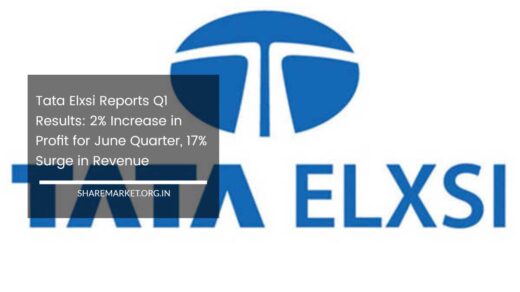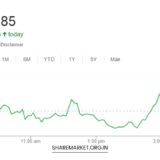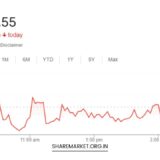Stock to Buy: 4 Stocks to Buy for Rapid Gains in the Coming Days

Stock to Buy
The recent decision by the US Federal Reserve has sent ripples through the global financial markets, influencing a notable uptrend in the Indian stock market.
On Thursday, both major indices, namely the Sensex and Nifty, soared to new record highs. This surge came in response to the Federal Reserve signaling a departure from its previous stance of tightening interest rates, opting instead for a potential series of rate cuts in the upcoming year.
The impact on the Indian market was immediate, with a more than 1% increase in both indices. Notably, IT and realty stocks emerged as the frontrunners in this bullish rally.
As the Sensex closed at 70,514.20, reflecting a rise of 929.60 points or 1.34%, and the Nifty closed at 21,182.70, with a gain of 256.35 points or 1.23%, investors are now keenly observing the market dynamics for potential opportunities.
Amidst this optimistic atmosphere, analysts have identified four breakout stocks that exhibit strong technical momentum, making them attractive candidates for short-term investments.
1. Bank of Baroda
Rating: Buy | Current Market Price: Rs 222 | Stop-loss: Rs 214 | Target: Rs 232-240
Sudeep Shah, the Head of Technical and Derivatives Research at SBI Securities, provided insights into the bullish potential of Bank of Baroda.
According to Shah, the stock witnessed a significant horizontal trendline breakout on the daily scale. This breakout momentum was further strengthened by the formation of a notable bullish candle along with the breakout.
Additionally, the stock’s Mansfield Relative Strength climbed above the zero line for the first time since November 6, indicating an outperformance compared to the Nifty-500 index.
Shah advised investors to consider maintaining a position in Bank of Baroda in the range of Rs 220-214, implementing a stoploss at Rs 222 to manage potential risks.
This recommendation is based on various technical and derivative aspects that collectively indicate robust bullish momentum in the stock.
2. Bajaj Finserv
Rating: Buy | Current Market Price: Rs 1729 | Stop-loss: Rs 1670 | Target: Rs 1820-1870
Rupak Dey, Senior Technical Analyst at LKP Securities, shed light on the promising outlook for Bajaj Finserv. Dey highlighted that the stock broke out of consolidation on the daily chart and is currently finding support at critical moving averages.
Critical moving averages are currently in a bullish crossover, and the stock is expected to maintain its upward momentum in the short term. Dey suggested potential price levels around 1,820/1,870 for Bajaj Finserv.
However, he cautioned that the stock could face downward pressure if it slips below the support level of Rs 1,670. This underlines the importance of monitoring key support levels for risk management in short-term trading strategies.
3. IndusInd Bank
Rating: Buy | Current Market Price: Rs 1547 | Stop-loss: Rs 1500 | Target: Rs 1700
IndusInd Bank emerged as another breakout candidate, drawing attention from analysts for its strong technical signals.
According to Rupak Dey, the stock moved out of consolidation on the daily chart, suggesting further upside potential.
The Relative Strength Index (RSI) is currently in a bullish crossover, indicating upward momentum that is expected to continue in the short term. Dey set a target of Rs 1,700 for IndusInd Bank, with a support level at Rs 1,500. A fall below this support level may lead to a decline in the stock.
Investors considering IndusInd Bank should carefully monitor these technical indicators and be prepared to adjust their positions based on market developments.
4. ICICI Bank
Rating: Buy | Current Market Price: Rs 1035 | Stop-loss: Rs 980
Shiju Kuthupalakkal, Technical Research Analyst at Prabhudas Lilladher, provided insights into ICICI Bank’s technical breakout.
According to Kuthupalakkal, ICICI Bank has given a clear breakout at the 1,020 level after consolidating for the last 6-7 sessions.
This breakout was accompanied by a sharp rise after the departure from the 930 level, highlighting the stock’s resilience.
Furthermore, Kuthupalakkal pointed out that ICICI Bank recently indicated a falling trendline breakout above the 980 zone, improving the overall bias and suggesting potential for further upside.
He anticipates the stock moving towards the next target prices of Rs 1,110 and Rs 1,240 in the coming days.
However, Kuthupalakkal also cautioned investors that if ICICI Bank breaks the level of 980, it could weaken the bias and lead to further declines.
This underscores the importance of setting stop-loss levels to manage risk in line with the dynamic nature of the market.
Analyzing the Market Dynamics
The bullish sentiment in the Indian stock market is primarily fueled by the recent shift in the US Federal Reserve’s stance on interest rates.
The indication of potential rate cuts in the coming year has injected optimism into the market, prompting investors to reassess their portfolios and explore short-term opportunities.
The technical analyses provided for the four breakout stocks—Bank of Baroda, Bajaj Finserv, IndusInd Bank, and ICICI Bank—highlight specific indicators that investors can consider in their decision-making process.
These include trendline breakouts, Mansfield Relative Strength, critical moving averages, and Relative Strength Index (RSI) crossovers.
While these technical indicators provide valuable insights, it’s crucial for investors to approach the market with a comprehensive understanding of both technical and fundamental factors.
External influences, global economic trends, and sector-specific news can significantly impact stock performance.
Risk Management Strategies
Investing in the stock market always carries inherent risks, and short-term trading amplifies these risks due to the rapid pace of market movements.
To mitigate these risks, investors should employ effective risk management strategies:
- Set Stop-Loss Levels: Each of the recommended stocks comes with suggested stop-loss levels, providing a predetermined exit point if the trade goes against expectations. Setting and adhering to stop-loss levels is a fundamental risk management practice.
- Diversify Portfolio: Avoid overconcentration in a single stock or sector. Diversifying the portfolio across different stocks and industries helps spread risk and reduce the impact of adverse events affecting a specific sector.
- Stay Informed: Keep abreast of market news, economic indicators, and global events that can influence stock prices. Informed decisions are key to navigating the dynamic nature of financial markets.
- Technical and Fundamental Analysis: Combine technical analysis, as highlighted in the stock recommendations, with fundamental analysis. Understanding the financial health and performance of a company provides a more comprehensive view of its potential for sustained growth.
- Regular Monitoring: Continuously monitor the market and adjust positions based on changing conditions. Markets are dynamic, and regular evaluation of portfolio holdings is essential for effective decision-making.
Final Thoughts
The recent surge in the Indian stock market, driven by the US Federal Reserve’s change in interest rate stance, presents short-term trading opportunities.
The identified breakout stocks—Bank of Baroda, Bajaj Finserv, IndusInd Bank, and ICICI Bank—offer potential gains based on strong technical momentum.
However, investors should approach the market with caution, recognizing the inherent risks associated with short-term trading.
Implementing effective risk management strategies, such as setting stop-loss levels, diversifying portfolios, staying informed, and combining technical and fundamental analysis, is crucial for navigating the dynamic nature of financial markets.
As always, investors are advised to conduct thorough research, consider their risk tolerance, and consult with financial professionals before making investment decisions.
The stock market’s unpredictable nature requires a disciplined and informed approach to achieve successful outcomes in both the short and long term.

















